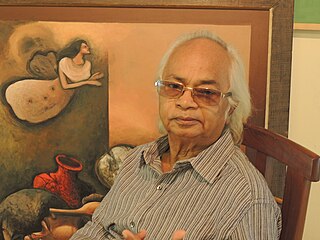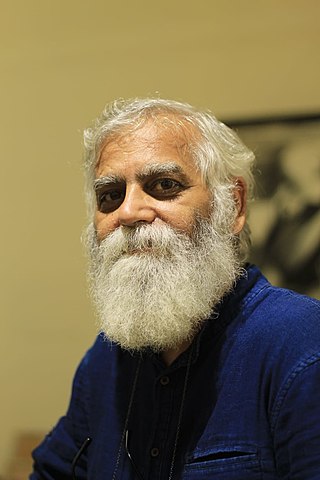Prayag Jha Chillar, also known as Prayag Jha, is a contemporary Indian artist, who specialized in etching. Her works are kept in collections all over India, including the National Gallery of Modern Art in the capital, Delhi. Jha's work was showcased in solo exhibitions from 1971 to 2012 across Jehangir Art Gallery, Taj Art Gallery, Bajaj Art Gallery, and Art Heritage New Delhi. Her work depicts scenes from the ancient Indian epic Meghdoot and is inspired by natural forms, such as grass and leaves. Jha's earlier works were primarily monochrome, but have evolved to include strong colors.
Sankho Chaudhuri was an Indian sculptor, and a noted figure in the art scene of India. (Although named Naranarain in due family tradition, he was more widely known by his pet name Sankho). Ram Kinker Baij was his teacher. He began close to cubism and then was influenced by István Beöthy, whom he had met in Paris. His themes have included the female figure and wildlife. He has worked in a wide range of media and produced large-scale reliefs and mobiles.

Bikash Bhattacharjee was an Indian painter from Kolkata in West Bengal. Through his paintings, he depicted the life of the average middle-class Bengali – their aspirations, superstitions, hypocrisy and corruption, and even the violence that is endemic to Kolkata. He worked in oils, acrylics, water-colours, conté and collage. In 2003, he was awarded the highest award of Lalit Kala Akademi, India's National Academy of Arts, the Lalit Kala Akademi Fellowship.
Haku Vajubhai Shah was an Indian painter, Gandhian, cultural anthropologist and author on folk and tribal art and culture. His art belonged to the Baroda Group and his works are considered in the line of artists who brought themes of folk or tribal art to Indian art.
Bhabesh Chandra Sanyal commonly known as B. C. Sanyal, the doyen of modernism in Indian art, was an Indian painter and sculptor and an art teacher to three generations of artists. During his lifetime he not just saw the partition of the Indian subcontinent three times, 1905, 1947 and 1971, but also witnessed 20th century Indian art in all its phases. His notable paintings include The flying scarecrow, Cow herd, Despair and Way to peace, which depicts Mahatma Gandhi with a Hindu and a Muslim child.

Biman Bihari Das is an Indian sculptor and former Principal of the Government College of Art & Craft, Kolkata. He was honoured by the Government of India, in 2014, by bestowing on him the Padma Shri, the fourth highest civilian award, for his services to the field of Fine Arts.

Alka Pande is an Indian academic, author and museum curator.

Aditya Pande is an Indian contemporary artist. His technique often involves a layering of surfaces along with mixed, diverse media ranging from vector drawing, digital photography, ink, acrylic paint to tinsel. His work combines the skills of drawing and printmaking with photography and painting.
Shiv Singh was an Indian-Punjabi artist, known mainly for his work as a sculptor.
Dhanraj Bhagat (1917–1988) was an Indian sculptor, considered by many as one of the major sculptors of the Indian subcontinent. He was born in 1917 in Lahore, in the erstwhile British India and secured a diploma in sculpture from the National College of Arts, Lahore. His career started as a member of the faculty at the College of Art, Delhi in 1947 where he rose to the position of the head of the Sculpture Department by the time of his retirement in 1977.
Gurcharan Singh is an Indian painter, known for his figurative paintings. He was born in 1949 at Patiala, in the Indian state of Punjab and studied at Government College of Arts and Crafts, Chandigarh. He has had several and group exhibitions in India and abroad and his works were exhibited at the International Biennale in Tokyo in 1984, at the Contemporary Art Show in Seoul in 1986 and the Festival of Contemporary Art in London in 1988. The Lalit Kala Akademi, New Delhi, National Gallery of Modern Art, New Delhi and India House, Paris have his on display at their premises. His signature paintings are based on the people from financially compromised classes; The Red Light in Black and White and Les Miserables are two of his notable works.
Manu Parekh is an Indian painter, known for his several paintings on the city of Varanasi. Reported to be influenced by Rabindranath Tagore and Ram Kinker Baij, Parekh is a recipient of the 1982 Lalit Kala Akademi Award. The Government of India awarded him the fourth highest civilian award of the Padma Shri, in 1991.
Ranbir Singh Bisht (1928–1998) was an Indian painter and the Principal of the College of Fine Arts, Lucknow University. Born in 1928 at Landsdowne in Garhwal, in the present day Indian state of Uttarakhand, he secured Drawing Teacher's Training Certificate and Diploma in Fine Arts from the Government College of Art and Craft, Lucknow. He conducted many solo shows in a number of Indian cities besides a show in New York and participated in group shows in Frankfurt and Tokyo. He was also a participant of the 4th Triennale at New Delhi in 1972.

Ranbir Kaleka is a contemporary Indian multi-media artist based in New Delhi whose work often centers around themes of animals, sexuality and tradition. Initially trained as a painter, his work has increasingly animated two-dimensional canvases within experimental film narrative sequences, and has been exhibited in a range of major international gallery and museum venues.

Manjot Kaur is a contemporary Indian artist, who lives and works in Chandigarh. She is currently a Visiting Artist Fellow at The Lakshmi Mittal and Family South Asia Institute, Harvard University, Cambridge, Massachusetts, USA.
The Government College of Arts, Chandigarh is an art institute in Chandigarh, India. Established in 1951 by SL Prashar, it offers professional education in art to students from over 68 years. This institute is one among the first three art institutions of India. It has a history of almost 132 years, initially, it was initially established as Mayo School of Industrial art in 1875 for purpose to provide industrial drawing as the world was on industrial revolution. John Lockwood Kipling was appointed as the first principal of the institution, which is now active as National College of Arts in Lahore. It came up on 16 August 1951 as splinter Mayo School of Arts, Lahore in Pakistan after Partition of India. In 1951 it was first established as Government School of Art and craft at Shimla, the capital of Punjab and subsequently Govt. College of art and craft, Chandigarh. On re-organization of Punjab, the control came under Chandigarh Administration. This institution is situated in Sector 10 C, adjoining the Government Museum and Art Gallery, Chandigarh.

Randeep Maddoke is a Punjab-based concept photographer and documentary filmmaker, born and raised in the village Maddoke, Moga (Punjab). Randeep, an activist turned photographer, is known for his focus on the pains of the marginalised sections of society which are constantly subject to a systematic social exclusion.
The Punjab Lalit Kala Akademi is Punjab's state academy of fine arts. It's an autonomous cultural organisation established and funded by the Government of Punjab to preserve and publicize the fine art and culture outside the state. Punjab Lalit Kala Akademi uplifts the study and research in field of paintings, sculptures, mixed-media art and photography.

Jagadish Chandra Dey, also known as Jagdish Dey, is an Indian painter and printmaker, known for his unique style of surrealism, where the real and unreal coexist. He has been a member of many art societies and juries.

Amit Dutt is an Indian painter from New Delhi, his paintings depict diverse facets of human nature and the social interdependence of man through multiple ties. He has done several national and international exhibitions in both solo and group format. His paintings are in collection of many art collectors in Indian and abroad, including Rashtrapati Niwas Shimla and National Gallery of Modern Art.













